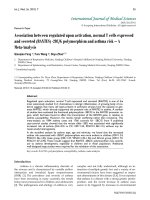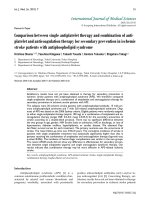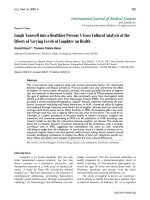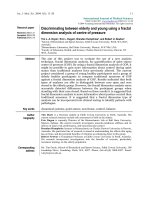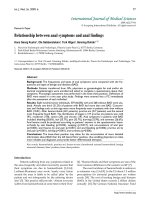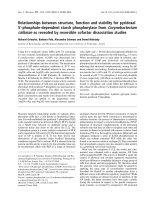Báo cáo y học: "Relationships between free radical levels during carotid endarterectomy and markers of arteriosclerotic disease"
Bạn đang xem bản rút gọn của tài liệu. Xem và tải ngay bản đầy đủ của tài liệu tại đây (898.09 KB, 7 trang )
Int. J. Med. Sci. 2007, 4
124
International Journal of Medical Sciences
ISSN 1449-1907 www.medsci.org 2007 4(3):124-130
© Ivyspring International Publisher. All rights reserved
Research Paper
Relationships between free radical levels during carotid endarterectomy
and markers of arteriosclerotic disease
Jagdish Gondalia
1
, Björn Fagerberg
2
, Johannes Hulthe
2
, Lars Karlström
3
, Ulf Nilsson
4
, Susanna Wa-
ters
5
, and Olof Jonsson
1
1. Department of Urology, Sahlgrenska University Hospital, Göteborg, Sweden
2.
Wallenberg Laboratory for Cardiovascular Research, Sahlgrenska University Hospital, Göteborg, Sweden
3.
Department of Vascular Surgery, Sahlgrenska University Hospital, Göteborg, Sweden
4. The Renal Center, Department of Nephrology, Sahlgrenska University Hospital, Göteborg, Sweden
5. Department of Carlsson Research, P.O.B. 444, Göteborg, Sweden
Correspondence to: Prof. Olof Jonsson, Tel: +46 31 3421000; fax: +46 31 821740; E-mail:
Received: 2006.12.09; Accepted: 2007.04.13; Published: 2007.04.14
Background: Free radical production is elevated in jugular venous blood emerging from the brain in conjunction
with carotid endarterectomy. This study explores the relationships between markers for lesion progression in
arteriosclerosis, production of radicals and clinical characteristics.
Methods: The radical production during carotid endarterectomy was studied in 13 patients with an ex vivo spin
trap method using OXANOH as a spin trap. MCP-1, ICAM-1, MMP-9 and oxLDL were determined in venous
blood samples before, during and after clamping of the carotid artery. Principal component analysis (PCA) as
well as partial least square regression analysis (PLS) was applied to interpret the data.
Results: PCA and PLS analysis revealed that high values of MMP-9 and low values of ICAM-1 were associated
with high radical production whereas MCP-1 and oxLDL were not correlated to radical production. MMP-9 was
elevated at diabetes, high haemoglobin, high leucocyte counts and thrombocyte counts as well as at contralateral
stenosis, whereas ICAM-1 showed reversed relationships to these clinical variables. MCP-1 increased during
surgery.
Conclusions: The main finding in our study is that MMP-9 in plasma is asscociated with radical production dur-
ing carotid endarterectomy, suggesting that this enzyme might be involved in the pathogenesis of brain damage
in conjunction with ischaemia-reperfusion.
Key words: Carotid endarterectomy; Free radicals; MCP-1; ICAM-1; MMP-9; oxLDL
1. INTRODUCTION
In previous studies we have described a tech-
nique to analyze the production of free radicals during
carotid endarterectomy based on determination of
radical production in vitro in venous blood samples
[1,2]. The rationale behind this in vitro technique is
that radical production continues in regional venous
blood draining a previously ischaemic area due to e.g.
activated leucocytes or ongoing lipid peroxidation.
Pre-treatment of the patients with a xanthine oxidase
inhibitor influences radical production, indicating that
oxidation of accumulated hypoxanthine has a role to
play in this process. The radical production is influ-
enced by several clinical parameters, e.g. occurrence of
contralateral stenosis, indicating that it is associated
with the severity of the arteriosclerotic disease. There
are several markers for the tissue damage characteris-
ing the lesion progression in arteriosclerosis, e.g.
MMP-9, ICAM-1, MCP-1 and oxLDL.
Rupture of atherosclerotic plaques is a key proc-
ess in symptomatic atherosclerosis. Fibrous caps from
ruptured atherosclerotic plaques contain less ex-
tracellular matrix than caps from intact plaques [3].
Enhanced matrix breakdown seems to be largely at-
tributable to matrix-degrading metalloproteinases
(MMP), which are expressed in atherosclerotic
plaques, mainly by macrophages and foam cells [3].
The MMP family is catalytically active, both in vitro
and in vivo. The activity of MMPs is increased by gene
transcription, extracellular activation of the secreted
inactive zymogen form, and reduced activity of tissue
inhibitors of metalloproteinases. Latent MMPs can be
activated by a number of molecules existing in the
atherosclerotic plaque, of which several are produced
by the macrophages, e.g. plasmin, reactive oxygen
species and others [3]. Serum concentration of MMP-9
has been suggested as a biomarker of plaque vulner-
ability [4]. In diabetic patients, carotid artery plaques
have more macrophages and higher levels of MMP-9
than non-diabetic patients [5].
The intercellular adhesion molecule ICAM-I me-
diates adhesion and transmigration of leucocytes to
the vascular endothelial wall, a step suggested as be-
ing critical in the initiation and progression of athero-
sclerosis. Circulating ICAM-I is associated with a fu-
Int. J. Med. Sci. 2007, 4
125
ture risk of stroke [6] and is elevated in diabetic pa-
tients [7].
Monocyte chemoattractant protein-1 (MCP-I)
originates from endothelial, epithelial, and glial cells
and mediates recruitment of monocytes into tissues
[8,9].
Oxidised LDL (oxLDL) seems to be a key antigen
in atherosclerosis and circulating levels of oxLDL have
been observed to predict the development of carotid
artery atherosclerosis [10,11].
Apart from atherosclerotic lesions, cerebral is-
chaemic damage may also cause increased radical
production and expression of ICAM-1 and MCP-1, or
be associated with increased MMP-9 production
[12-16].
Accordingly, we explored whether there were
any associations between the levels of MMP-9, MCP-1,
ICAM-1, oxLDL, and free radicals in blood from the
jugular vein, as well as variables related to athero-
sclerosis during endarterectomy.
2. MATERIAL AND METHODS
2.1. Patients
The 13 patients included in the present study
were identical to the control group in our previous
work concerning the effects of pre-treatment with a
xanthine oxidase inhibitor on free radical levels dur-
ing carotid endarterectomy in patients operated on for
symptomatic carotid artery stenosis [2]. Relevant data
concerning the patients are presented in Table 1.
TABLE 1. Characteristics of the patients
2.2. Methods
2.2.1. Anaesthesia
The patients were premedicated with a combina-
tion of pethidine and dixyrazine (Esucos®) according
to their weight and were then operated on under fen-
tanyl-assisted general anaesthesia.
2.2.2. Operation
The operation performed was described in detail
in our previous article. Briefly, the carotid artery was
exposed via an incision along the anterior border of
the sternocleidomastoid muscle. A 1-mm catheter was
inserted via the facial vein into the jugular vein and
advanced up to the level above the skull base, and the
facial vein was divided. The catheter was advanced
12-15 cm up until resistance and then withdrawn 1 cm
until blood could be aspired without resistance. The
common carotid and internal carotid artery were iso-
lated separately without touching the carotid bifurca-
tion, whereafter the external carotid artery was iso-
lated.
After clamping the common and external carotid
artery, stump pressure was measured using an arterial
pressure monitor via a needle inserted into the inter-
nal carotid artery distal to the stenotic lesion. A shunt
was not considered necessary in any case. After
clamping the internal carotid artery, the internal and
common carotid arteries were opened via a longitu-
dinal arteriotomy and the plaque removed.
The arteriotomy was closed using 6-0 prolene
continuous sutures. In two cases, in each group, the
arteriotomy was closed using a patch to avoid nar-
rowing of the internal carotid artery. There was no
mortality and no cardiac or cerebral complications.
2.2.3. Sampling procedure
After declamping, blood flow was monitored
using a sterile doppler probe and a flow meter
(Medistim R, Vingmed, Sweden). From the catheter,
inserted into the jugular vein, 4 cm
3
blood samples
were drawn three times at 5-minute intervals, before
clamping the carotid artery, once one minute after
clamping and once three minutes before declamping.
Another four 4-cm
3
samples were drawn at 1, 5, 10
and 15 minutes after declamping. Due to the place-
ment of the catheter it is unlikely that the blood sam-
ples were contaminated with blood from the external
head.
After heparinisation, each venous blood sample
was divided into two 1-ml portions (one sample and
one blank) and pipetted into Eppendorf tubes.
OXANOH (v.i.) (1 mM final concentration) was added
to both tubes. In order to distinguish the part of the
electronic spin resonance (ESR) signal attributable to
superoxide and/or hydroxyl radicals, superoxide
dismutase, catalase and desferrioxamine were added
to the blank tube to a final concentration of 0.1 mg ml
-1
,
16,000 units ml
-1
and 0.4 mg ml
-1
, respectively
.
The
same volume of isotonic sodium chloride as used to
solute the scavenger substances was added to the
sample tube. Subtraction of the ESR signal seen in the
samples treated with an antioxidant cocktail from that
of the saline samples yields the part of the signal that
can be attributed to superoxide and/or hydroxyl
radicals or any secondary radicals dependent on these.
The tubes were shaken and centrifuged at 14,000 rpm
for one minute. The plasma was removed immediately
and frozen in liquid nitrogen and the time from sam-
pling to freezing was thus less than two minutes.
Int. J. Med. Sci. 2007, 4
126
2.2.4. Measurement of radical production
OXANOH was used as a spin trap. The stable ni-
troxide radical 2-ethyl-2,4,4-trimethyloxazolidine-
-3-3-yloxy (OXANO
•
) was reduced to the hydroxyl-
amine spin trap 2-ethyl-3-hydroxy-2,4,4--
trimethyloxazolidine (OXANOH) by gassing a 10 mM
solution of the radical with hydrogen for 45 minutes
in the presence of the catalyst platinum dioxide (PtO
2
).
On contact with a radical, OXANOH is reoxidised to
OXANO
•
, which can be measured by ESR. The spin
trap was freshly prepared before each experiment and
kept on ice until used.
The samples were transported to the electronic
spin resonance laboratory and thawed. The concentra-
tion of OXANO
•
was analysed using a Bruker ECS 106
ESR spectrometer. The spectrometer settings were as
follows: field centre, 3478 G; modulation amplitude, 1
G; microwave power, 10 mW; microwave frequency,
9.70 GHz; scan range, 5 G; scan rate, 1 G s
-1
; time con-
stant, 20 ms. The ESR signal was quantified by signal
height peak to trough.
The concentration of OXANO in the blank sam-
ple was subtracted from that of the corresponding test
sample. Around ten per cent of the signal was dimin-
ished as a result of the inhibitors.
2.2.5. Measurement of MCP-1, ICAM-1, MMP-9 and oxLDL
Blood samples were withdrawn for an analysis of
markers of arteriosclerosis together with OXANO
samples 1, 5 and 9, i.e. before clamping, just before
declamping and 15 minutes after start of reperfusion.
The blood samples were heparinised and centrifuged,
whereafter the plasma was frozen in liquid nitrogen
for later analysis. MCP-1, ICAM-1 and MMP-9 were
measured using commercially available ELISA kits
from R&D systems, UK.
OxLDL concentration in plasma that had been
stored at –70ºC was measured by a sandwich ELISA
(Mercodia, Uppsala, Sweden) utilizing the same spe-
cific murine monoclonal antibody, mAb-4E6, as in the
assay described by Holvoet et al [17]. Using this anti-
body (mAb-4E6) it is possible to measure very small
amounts OxLDL containing a conformational epitope
in the apoB-100 moiety of LDL that is generated as a
consequence of substitution of lysine residues of
apoB-100 with malondialdehyde. The specificity for
the antibody mAb-4E6 has been assessed, showing
that 50% inhibition of binding of mAb-4E6 to immobi-
lized OxLDL was obtained with 0.025 mg/dl Cu
2+
OxLDL and with 25 mg/dl native LDL [18]. In the
presently used sandwich ELISA, the plates are coated
with the capture antibody (mAb-4E6), and the secon-
dary antibody specifically detects apoB. In a set of 20
EDTA-plasma samples collected from 20 different in-
dividual blood-donors no unspecific binding of native
LDL to the solid phase in the Mercodia oxidized LDL
ELISA system was detected (data not shown). The
precision has in our hands previously been shown to
be satisfactory [19].
2.3. Statistics
The mean values for concentrations of OXANO
and markers of arteriosclerosis before, during and af-
ter clamping are given. When analysing the relations
between radical production and concentrations of
MCP-1, ICAM-1, MMP-9 and oxLDL, mean values for
all the OXANO concentrations measured during
clamping and reperfusion and for the markers sam-
pled before, during and after clamping were used. In
the PLS models, where values for MMP-9 and ICAM-1
were compared to various parameters, mean values
for the markers obtained before, during and after
clamping were used.
Due to the small number of patients, standard
descriptive statistics did not seem optimal. Instead,
principal component analysis (PCA) was performed
on the total data set. All variables were scaled to zero
mean and unit variance. A detailed description of the
computational steps involved in a PCA is given in Ref.
20. In essence, a variance/covariance matrix is calcu-
lated based on the scaled variables. Principal compo-
nents are calculated as the eigen-vectors of this matrix,
yielding the variable loadings shown in variable
loading plots. The first principal component has the
capacity to encompass a maximum of the variance in
one single vector, which is a linear combination of all
variables analysed. Each subsequent component con-
stitutes an independent linear combination of vari-
ables, capturing a maximum of the variance remaining
in the data set, and is orthogonal to all other compo-
nents. In biological material, with a considerable de-
gree of collinearity between the variables measured,
the first component thus represents a large part of all
information, compressed into one variable. The sub-
sequent principal components represent independent
information, in decreasing order of magnitude. In ad-
dition to reducing a large data set to a few compo-
nents that can be easily overviewed, principal com-
ponent-based analyses have important, inherent
noise-reducing properties due to the simultaneous
analysis of several variables. This is analogous to the
reduction in noise gained by using large samples,
where the large number of objects increases the preci-
sion of, for example, the sample mean. Results thus
generated by PCA-based methods are more robust
than corresponding univariate descriptors or bivariate
correlation analyses. Compared with multiple regres-
sion techniques, the latter are highly sensitive to dis-
tribution and colinearities, while PCA can be applied
to any kind of data, regardless of distribution, and, as
outlined above, utilises the covariances to reduce
noise and to compact the data. In subsequent analyses,
Partial Least Square (PLS) regression analyses were
applied [20]. As with PCA, the principal components
are extracted with the modification that they are con-
strued to find a regression between X- and Y-data in
addition to producing a compact representation of the
data. In the calculation of principal components, the
components of the X-block that produce the strongest
linear relation to the Y-variables are extracted. The
principal difference is that in PLS, a number of (one or
Int. J. Med. Sci. 2007, 4
127
several) Y-variables are defined. For the regression
coefficients yielded in PLS analyses, standard errors
were estimated using the jack-knife procedure [21],
which is a non-parametric, general principle for the
estimation of errors in various estimates, suitable for
PLS regression coefficients. All PCA and PLS models,
as well as graphics and standard error estimates, were
generated using the Simca-P 8.0 Software (Umetrics,
Inc.).
Anova and paired T-test were used to test for
differences in concentrations of MCP-1, ICAM-1,
MMP-9 and oxLDL with time during the operations
and p < 0.05 (two-sided) was considered statistically
significant.
3. RESULTS
The mean values for all OXANO measurements
performed during and after clamping were numeri-
cally higher than the baseline measurements although
no statistically significant change was observed due to
the great variations (Fig. 1).
Fig. 1 Free radical production measured in vitro in blood sam-
ples from the internal jugular vein. Mean values +
SEM are
given for OXANO values obtained before clamp, during clamp
and at reperfusion. n = 13.
The atherosclerosis markers show some changes
during surgery (Fig. 2). MCP-1 increased significantly
from the first time-point to the second and third ones,
while oxLDL tended to decrease. No statistically sig-
nificant change was observed concerning MMP-9 and
ICAM-1.
The outcome of the PCA of the radical data, data
concerning the degree of arteriosclerotic disease and
some relevant clinical data are shown in Figure 3. In
order to increase the lucidity of the figure the PCA has
been modified by presenting the OXANO values as
mean values before, during and after clamping the
carotid artery. The OXANO radical levels (PL, I, RP)
are located in a cluster at the far left of the X-axis to-
gether with the MMP-9 values, indicating a positive
correlation between these variables. ICAM-1 values
are located in the opposite direction, indicating a
negative correlation with OXANO levels as well as
MMP values. MCP-1 and oxLDL values are close to
origin, indicating a lack of correlation between these
values and any of the other variables.
MMP-9 values appear from this PCA to be posi-
tively correlated to e.g. platelets, leucocytes and dia-
betes and negatively correlated to age, while the op-
posite situation appears to be true for ICAM-1 values.
A closer analysis of the significances of these re-
lationships is given in the PLS analyses. The PLS re-
gression analysis describing how OXANO levels de-
pend on values for oxLDL, MMP-9, ICAM-1 and
MCP-1 is presented in Figure 3. As suggested from the
PCA analysis, there is a strong positive correlation
between MMP-9 and radical production and a nega-
tive correlation between ICAM-1 values and OXANO
levels.
The regression coefficients relating various clini-
cal parameters and MMP-9 or ICAM-1 values are
shown in Figures 4 and 5 respectively.
Fig. 2 Mean values (SEM) of oxLDL, MMP9, ICAM1 and
MCP1 determined before clamping (1), during clamping (5) and
15 minutes after declamping (9). Stars denote significant dif-
ferences compared to preclamp values. * p < 0.05, ** p < 0.01.
Fig. 3 Variable loadings derived from a PCA of some of the
recorded data. The position of each variable in the loading plot
indicates its relationship to other variables. Strongly correlated
variables are located close to each other. Abbreviations: PL, I
and RP OXANO levels at baseline, clamp and reperfusion re-
spectively. MCP11, MCP15, MCP19; MCP levels before, dur-
ing and after clamping, ICAM11, ICAM15, ICAM19; ICAM
levels before, during and after clamping, MMP91, MMP95,
MMP99; MMP9 levels before, during and after clamping,
oxLDL1, oxLDL5, oxLDL9; oxLDL levels before, during and
after clamping, Collateral; degree of collateral circulation,
Stenosis; degree of ipsilateral stenosis, Left; operation for
Int. J. Med. Sci. 2007, 4
128
left-side stenosis, Diabetes; occurrence of diabetes, Leucocyt;
white blood cell count, Hb; haemoglobulin concentration,
Trombocyt; trombocyte count.
Fig. 4 Regression coefficients in a PLS model relating radical
production to oxLDL, MMP9, ICAM1 and MCP1 determined
before clamping (1), during clamping (5) and 15 minutes after
declamping (9). Shown are scaled and centred regression coef-
ficients with standard errors estimated by the jack-knife pro-
cedure. If the bars do not include the zero line a significant
relationship prevails. A positive coefficient indicates a positive
relationship to radical production and vice versa.
Fig. 5 Regression coefficients in a PLS model relating MMP9
levels to various clinical variables. Shown are scaled and cen-
tred regression coefficients with standard errors estimated by the
jack-knife procedure. If the bars do not include the zero line a
significant relationship prevails. A positive coefficient indicates
a positive relationship to radical production and vice versa.
Fig. 6 Regression coefficients in a PLS model relating ICAM1
levels to various clinical variables. Shown are scaled and cen-
tred regression coefficients with standard errors estimated by the
jack-knife procedure. If the bars do not include the zero line a
significant relationship prevails. A positive coefficient indicates
a positive relationship to radical production and vice versa.
Increased MMP-9 values are found in conjunc-
tion with diabetes, high haemoglobin, leucocyte and
platelet values and at contralateral stenosis while low
values are found in conjunction with high age, high
blood pressure, operation for left-side stenosis and
high stump pressure.
As regards ICAM-1, high values are found in
conjunction with heavy weight, operation for left-side
stenosis and high stump pressure. Low values are
found in conjunction with diabetes, high haemoglobin,
leucocyte and thrombocyte values and when a contra-
lateral stenosis is present.
4. DISCUSSION
The present study concerns the relationships
between the production of free radicals during and
after operation for stenosis of the carotid artery and
blood levels of ICAM-1, MMP-9, MCP-1 and oxLDL.
Radical production has been calculated using an ex
vivo spin trap technique with OXANOH as the spin
trap. High values for MMP-9 and low values for
ICAM-1 were associated with high levels of free radi-
cals. Several correlations were found between the
values of MMP-9 and ICAM-1 and different clinical
variables. In an earlier study where the present group
of patients were included as controls and compared to
allopurinol-pretreated patients, relations between
various clinical variables and radical production were
reported [2].
MMPs are a group of zinc-dependent enzymes
that degrade the molecules of the extracellular matrix.
It has been shown that matrix degradation caused by
these proteinases occurs during progression of
atherosclerosis [22]. Furthermore, an increase in MMP
activity occurs after stroke, which contributes to is-
chaemic brain injury, including infiltration of leuco-
cytes in the damaged tissue [12-14]. In animal experi-
ments it has been demonstrated that inhibition of
MMP-9 reduces brain injury after stroke [23]. MMP-9
levels are increased in internal jugular venous blood
after traumatic brain injury in patients [15]. These
studies indicate that MMP-9 is involved in the patho-
genesis of brain damage due to various causes. Our
results of a positive correlation between levels of free
radicals and MMP-9 at operation for carotid artery
stenosis further support this role of metalloproteinases
in brain tissue damage. The positive correlation be-
tween MMP-9 and leucocyte counts also appears
logical since neutrophils can also produce these en-
zymes [14]. Our finding of a positive association be-
tween MMP-9 and diabetes fits in well with previous
observations [5].
The occurrence of contralateral stenosis was as-
sociated with higher MMP-9 values, suggesting that a
more severe atherosclerotic disease causes elevated
MMP-9 levels. Inhibition of MMP-9 in conjunction
with these operations might be useful to decrease pos-
sible brain damage.
The plasma concentration of ICAM-1 as well as
other adhesion molecules is increased in conjunction
with transient ischaemic attacks, indicating a central

